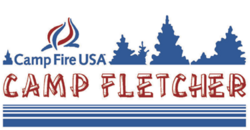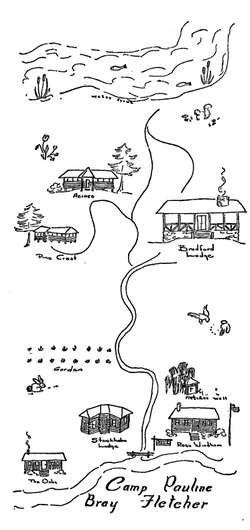Camp Fletcher: Difference between revisions
No edit summary |
|||
| (4 intermediate revisions by the same user not shown) | |||
| Line 1: | Line 1: | ||
[[Image:Camp Fletcher logo.png|right|250px]] | [[Image:Camp Fletcher logo.png|right|250px]] | ||
'''Camp Pauline Bray Fletcher''' is a 250-acre summer camp near [[Tannehill State Park]] at 5150 [[Fletcher Road]] in [[Bessemer]]. It is presently operated by the [[Camp Fire USA Central Alabama Council]]. | [[File:1948 Camp Fletcher map.png|right|thumb|250px|1948 map of Camp Fletcher]] | ||
'''Camp Pauline Bray Fletcher''' (originally '''Camp Margaret Murray Washington''') is a 250-acre summer camp near [[Tannehill State Park]] at 5150 [[Fletcher Road]] in [[Bessemer]]. It is presently operated by the [[Camp Fire USA Central Alabama Council]]. | |||
The camp was founded in [[1926]] by nurse [[Pauline Fletcher|Pauline Bray Fletcher]] as a convalescent camp for African American women and children. The original 57 acre property was expanded before [[1947]] with the purchase of an additional 80 acres acquired by bartering timber rights on the original camp. | The camp was founded in [[1926]] by nurse [[Pauline Fletcher|Pauline Bray Fletcher]] as a convalescent camp for African American women and children. It was named for [[Margaret Murray Washington]], wife of educator [[Booker T. Washington]]. The camp began operating on [[June 22]] of that year. The original 57 acre property was expanded before [[1947]] with the purchase of an additional 80 acres acquired by bartering timber rights on the original camp. | ||
After Bray's retirement, the camp's operations were assumed by the [[Youth Service League|Girl's Service League]], which became the Youth Service League. | After Bray's retirement, the camp's operations were assumed by the [[Youth Service League|Girl's Service League]], which became the Youth Service League. The camp was renamed in honor of its founder in [[1942]]. Other agencies made use of the camp and its facilities for their owen programs, including the [[Girl Scouts of America]], the [[Women's Missionary Union]], the [[Baptist Women's State Convention]], the [[Negro Boys' Club of Birmingham]], the [[4-H Club]], the [[YWCA]], and the [[North Birmingham Gospel Chapel]]. | ||
On [[June 10]], [[1948]] the camp was raided by members of the [[Ku Klux Klan]] | On [[June 10]], [[1948]] the camp was raided by members of the [[Federated Ku Klux Klans Inc.|Federated Knights of the Ku Klux Klan]] during a training session for Girl Scout leaders. The group of black leaders were being trained by two white instructors working for the Memphis Regional Girl Scout Office. The attackers searched the women's pocketbooks and wrote down their names and addresses. The instructional session was halted the next day and all participants sent home. The incident, along with a similar raid two days earlier at [[Camp Blossom Hill]] in [[Birmingham]]'s [[Brummitt Heights]] neighborhood, prompted [[Birmingham]] attorney [[Abe Berkowitz]] to form a coalition of business and civic groups to demand better enforcement against Klan terrorism. In [[1949]] Governor [[Jim Folsom]] signed an "Anti-Masking Bill" aimed at reducing Klan activity. | ||
Camp Fire USA began leasing the camp during the summers in [[1981]]. The YSL merged with Camp Fire in [[2003]] in order to help preserve the camp. Currently Camp Fletcher boasts a 100-seat dining hall, three dormitory cabins, an outdoor environmental classroom, a swimming pool, low ropes course, and general store. [[Shades Creek]] provides opportunities for swimming and canoeing. | Camp Fire USA began leasing the camp during the summers in [[1981]]. The YSL merged with Camp Fire in [[2003]] in order to help preserve the camp. Currently Camp Fletcher boasts a 100-seat dining hall, three dormitory cabins, an outdoor environmental classroom, a swimming pool, low ropes course, and general store. [[Shades Creek]] provides opportunities for swimming and canoeing. | ||
==Camp structures== | |||
* "Rose Windham Hut" (1926), a 30'x60' frame building housing the camp director's office and quarters as well as 12 campers and an additional staff member. The building was donated by contractor [[T. C. Windham]] and named in memory of his daughter, Rose. | |||
* "The Oaks" (1927), a five-room building housing the camp's full-time cook along with additional campers. The building was constructed with funds obtained by mortgaging Fletcher's home | |||
* "Pine Crest" (1929), a building accommodating 36 campers and four staff members. The building was constructed with funds raised by faculty members at Birmingham's segregated black schools | |||
* "Juliette Bradford Memorial Lodge" (1935), housed the camp's kitchen and pantry, along with quarters for a male assistant director and a large, open-sided dining hall seating 110 people. The building was constructed with funds raised by the [[Birmingham Federation of Negro Women's Clubs]], which was named in honor of educator and civic worker [[Juliette Bradford]] | |||
* "ACIPCO Hut" (1939), a building accommodating 36 campers and four staff members. The building was constructed with funds raised by employees of the [[American Cast Iron Pipe Company]] | |||
* "Stockham Lodge" (1948), a log cabin for use as an administrative office and residence for the camp director with additional sleeping porches on front and back. The lodge, costing $2,714, was paid for by Lieutenant [[Richard Stockham]]. | |||
==References== | ==References== | ||
* ''A Brief History of Camp Pauline Bray Fletcher, 1926 to 1963: And a Biographical Sketch of Its Founder'' | * ''A Brief History of Camp Pauline Bray Fletcher, 1926 to 1963: And a Biographical Sketch of Its Founder'' | ||
* Watts, Carrie E. (August 1, 1948) "[http://digitalcommons.auctr.edu/cgi/viewcontent.cgi?article=2242&context=dissertations History and development of Camp Pauline Bray Fletcher, Bessemer, Alabama, with emphasis on the 1947 program]" Master's Thesis, Atlanta University School of Social Work. ETD Collection for AUC Robert W. Woodruff Library. Paper 704. | * Watts, Carrie E. (August 1, 1948) "[http://digitalcommons.auctr.edu/cgi/viewcontent.cgi?article=2242&context=dissertations History and development of Camp Pauline Bray Fletcher, Bessemer, Alabama, with emphasis on the 1947 program]" Master's Thesis, Atlanta University School of Social Work. ETD Collection for AUC Robert W. Woodruff Library. Paper 704. | ||
* Wilson, Hayley (April 20, 2022) "[http://www.birminghamtimes.com/2022/04/how-bessemers-hidden-gem-camp-fletcher-changes-lives-of-young-people/ How Bessemer’s Hidden Gem — Camp Fletcher — Changes Lives of Young People]" {{BT}} | |||
==External links== | ==External links== | ||
* [http:// | * [http://campfletcher.com Camp Fletcher] website | ||
[[Category:Campgrounds]] | [[Category:Campgrounds]] | ||
[[Category:1926 establishments]] | [[Category:1926 establishments]] | ||
[[Category:Fletcher Road]] | [[Category:Fletcher Road]] | ||
[[Category:Shades Creek]] | |||
Latest revision as of 16:57, 25 April 2022
Camp Pauline Bray Fletcher (originally Camp Margaret Murray Washington) is a 250-acre summer camp near Tannehill State Park at 5150 Fletcher Road in Bessemer. It is presently operated by the Camp Fire USA Central Alabama Council.
The camp was founded in 1926 by nurse Pauline Bray Fletcher as a convalescent camp for African American women and children. It was named for Margaret Murray Washington, wife of educator Booker T. Washington. The camp began operating on June 22 of that year. The original 57 acre property was expanded before 1947 with the purchase of an additional 80 acres acquired by bartering timber rights on the original camp.
After Bray's retirement, the camp's operations were assumed by the Girl's Service League, which became the Youth Service League. The camp was renamed in honor of its founder in 1942. Other agencies made use of the camp and its facilities for their owen programs, including the Girl Scouts of America, the Women's Missionary Union, the Baptist Women's State Convention, the Negro Boys' Club of Birmingham, the 4-H Club, the YWCA, and the North Birmingham Gospel Chapel.
On June 10, 1948 the camp was raided by members of the Federated Knights of the Ku Klux Klan during a training session for Girl Scout leaders. The group of black leaders were being trained by two white instructors working for the Memphis Regional Girl Scout Office. The attackers searched the women's pocketbooks and wrote down their names and addresses. The instructional session was halted the next day and all participants sent home. The incident, along with a similar raid two days earlier at Camp Blossom Hill in Birmingham's Brummitt Heights neighborhood, prompted Birmingham attorney Abe Berkowitz to form a coalition of business and civic groups to demand better enforcement against Klan terrorism. In 1949 Governor Jim Folsom signed an "Anti-Masking Bill" aimed at reducing Klan activity.
Camp Fire USA began leasing the camp during the summers in 1981. The YSL merged with Camp Fire in 2003 in order to help preserve the camp. Currently Camp Fletcher boasts a 100-seat dining hall, three dormitory cabins, an outdoor environmental classroom, a swimming pool, low ropes course, and general store. Shades Creek provides opportunities for swimming and canoeing.
Camp structures
- "Rose Windham Hut" (1926), a 30'x60' frame building housing the camp director's office and quarters as well as 12 campers and an additional staff member. The building was donated by contractor T. C. Windham and named in memory of his daughter, Rose.
- "The Oaks" (1927), a five-room building housing the camp's full-time cook along with additional campers. The building was constructed with funds obtained by mortgaging Fletcher's home
- "Pine Crest" (1929), a building accommodating 36 campers and four staff members. The building was constructed with funds raised by faculty members at Birmingham's segregated black schools
- "Juliette Bradford Memorial Lodge" (1935), housed the camp's kitchen and pantry, along with quarters for a male assistant director and a large, open-sided dining hall seating 110 people. The building was constructed with funds raised by the Birmingham Federation of Negro Women's Clubs, which was named in honor of educator and civic worker Juliette Bradford
- "ACIPCO Hut" (1939), a building accommodating 36 campers and four staff members. The building was constructed with funds raised by employees of the American Cast Iron Pipe Company
- "Stockham Lodge" (1948), a log cabin for use as an administrative office and residence for the camp director with additional sleeping porches on front and back. The lodge, costing $2,714, was paid for by Lieutenant Richard Stockham.
References
- A Brief History of Camp Pauline Bray Fletcher, 1926 to 1963: And a Biographical Sketch of Its Founder
- Watts, Carrie E. (August 1, 1948) "History and development of Camp Pauline Bray Fletcher, Bessemer, Alabama, with emphasis on the 1947 program" Master's Thesis, Atlanta University School of Social Work. ETD Collection for AUC Robert W. Woodruff Library. Paper 704.
- Wilson, Hayley (April 20, 2022) "How Bessemer’s Hidden Gem — Camp Fletcher — Changes Lives of Young People" The Birmingham Times
External links
- Camp Fletcher website

